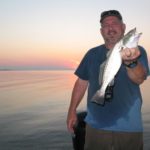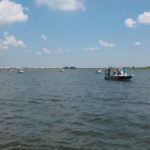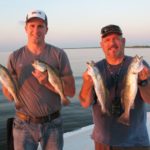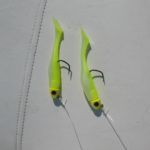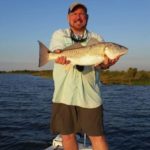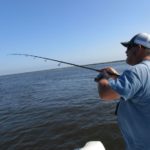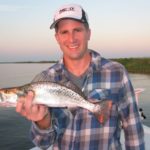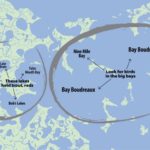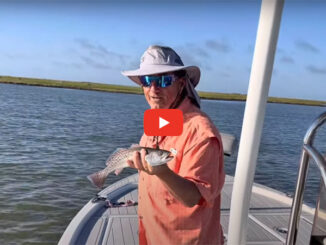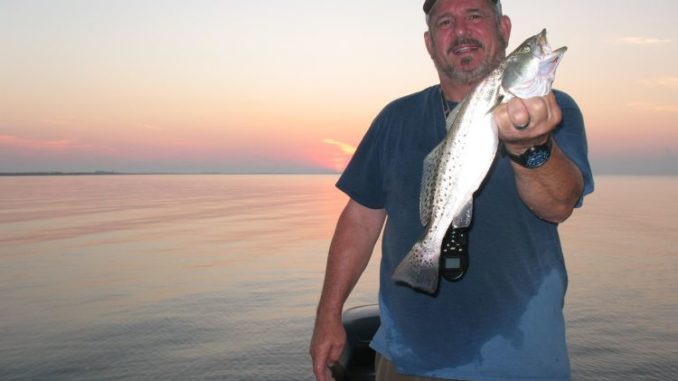
When the oppressive heat of August beats down on the Louisiana coast, head to the upper Biloxi Marsh to catch specks and reds.
This goes down as one of my very best summers — ever.
June came in with intense heat and sweltering humidity, and an abundance of speckled trout. At least it did where I was fishing — in and around Bay Eloi.
I’d made some early summer trips to the MRGO Rocks, but never did get on a decent bite. Next, I started hitting Comfort Island, which usually pays off in speckled dividends during the early summer.
But not this year, at least not for me.
Admittedly, my two trips out there were both under less than ideal conditions. On both trips the seas were kicking, and the winds were blowing and the water was ugly.
And both trips resulted in little or nothing.
So on my last fruitless trip to Comfort Island, I decided to try a few of the old reefs I used to fish in bygone years, just to see what would happen.
What happened was we limited out on speckled trout, in pretty short order. On my next trip I headed right back to the exact spot where I spanked them the week before, hoping to pick up where I left off.
We caught four fish. Four.
I was so sure those fish would be there that I wouldn’t leave. I just knew the bite would start up any minute. It didn’t, and after several barren hours, I decided to give it up.
They weren’t there and they weren’t coming — at least not that day.
To say I was disappointed was an understatement.
So, with the midday hour approaching and the sun turned up full blast, I figured I’d try another of those reefs I fished in days gone by, before calling it a day.
The trout were waiting. They ate up our live shrimp, and while we did have to cull a bunch of undersized fish, we caught our limits of legal specks and headed to the camp to clean fish.
I figured I was on to something, and I couldn’t wait to hit those reefs again.
My next trip was the kind you talk about for years. We went straight to the same reef and started fishing, and had a three-man limit of specks by 9 a.m.
School was out, so I brought my grandson Caleb Giraud along on the next trip, and found some trout still there, but it wasn’t like before.
The fish were scattered, and we had to move a few times and grind it out, but by 1:15 p.m. we once again had our limits.
However, that makes for a very long day. By the time you get back to the dock, clean the boat, clean the fish and drive home, you’re more than exhausted.
I told myself that I’m too old and too tired to have many more successful days like that.
And besides, I could see the handwriting on the wall: The reefs I’d been fishing were all in shallow water, nowhere over 3 feet deep. And by mid June the thermometer parked in the mid-90s, and we even touched 100 degrees one day.
I knew those trout would be leaving those shallow reefs and looking for deeper, cooler water. It happens every year.
I figured I’d start heading farther out into Bay Eloi and maybe hit some of the normal deep summer hotspots in Breton Sound.
So I called Freedom Charters’ Capt. Mike May (985-788-6044) to see if it was possible to jump aboard with him for a spur-of-the-moment trip.
Capt. Mike and I have talked several times but never fished together, and he always told me to let him know when I wanted to go fishing.
So we worked out a schedule to get on the water.
May was headquartered out of Hopedale for four or five years, but a couple years ago he decided to make the Rigolets Marina his home port. It was closer to home, and he said he was catching some very nice specks and reds, even in the summer heat.
He asked if we could do a trip in the Rigolets area and the upper-east side Biloxi Marsh, instead of Breton Sound, and I quickly agreed — I’m always ready to explore some new territory.
I picked up a mutual friend, David Hassenboehler of Next Generation Ministries, and we met May just before daybreak.
He already had his bay boat in the water and a baitwell stocked with frisky live shrimp. We tossed our gear aboard and got underway.
May had a float plan for the morning that included a short stop on the Lake Borgne side of Rigolets Pass and then the 10-mile haul across Lake Borgne to the upper east side of the Biloxi Marsh, where he said he’s been catching specks and reds.
As we passed the L&N train bridge, a half dozen boats were already lined up along the northeast side of the bridge.
The word was out that both hefty specks and big reds were hanging along the shelf, where the depth drops to over 30 feet.
A sliding sinker rig, using a 1-ounce weight, 12 to 18 inches of leader and a live shrimp is the ticket to get your rod bent, May said.
He said specks will move into that deeper water as the summer wears on because that’s where they can fine cooler water temps.
“If you plan to fish shallow for trout, you’ll want to do it very early because once the sun gets up the fish will spread out looking for deeper water,” May said.
May said sometimes the shallow-water trout bite is over as early as 7:30 a.m., so you really do have to get an early start.
The weathermen predicted west winds at 8 to 15 mph, which is not what you’d call optimum conditions.
May said any wind direction is fishable as long as it’s 10 mph or less. Once it hits 15 mph, the seas kick up and the ride gets rough.
Worse yet, west winds push water out of the marsh and make for muddy water conditions.
Of course, we were greeted by west winds at a pretty steady 15 mph.
May almost decided not to make the bumpy ride across the open water, but we were all feeling adventurous and we encouraged him.
Our first stop was at an inconspicuous point. The water clarity looked pretty good.
May had put a half dozen hefty specks in the boat at this point the day before, so he was eager to see if there would be a repeat performance.
May and Hassenboehler fished with a couple of the captain’s rigs.
He uses Penn Battle reels mounted on sturdy rods. Some reels are spun with braid, while others were spooled with mono — but all were rigged with No. 6 treble hooks under 18- to 24-inch leaders dangling below H&H popping corks.
A split-shot squeezed tight on the leader about 8 inches above the hook completed the rig.
Live shrimp made the offering irresistible to hungry predators.
My rig was almost identical, except I used a kahle hook instead of a treble hook, and I caught the first trout of the day.
Hassenboehler and May caught several more — all very respectable fish.
Definitely much larger than the ones I’d been catching the previous couple of weeks.
We sat at that point and continued to put trout up to 2 pounds in the boat. We caught some junk fish in the mix, including sail cats, hardheads, small white trout and ladyfish — but that’s par for the course when summer fishing.
May said he fishes several of the big bays on the upper east side, including Nine Mile Bay, Three Mile Pass, Blind Bay, Bay Boudreaux and False Mouth Bay.
Three things to look for
“I’ll look for three things this month when fishing the big bays,” May said. “One, I look for birds. If the birds are diving over bait, I go fish under them. There is almost always going to be fish under those birds. Sometimes its junk fish, sail cats, jacks or undersized trout, but often it’s keeper trout — and we’ve caught some surprising-sized trout under the birds this summer.
“The point is, don’t ignore the birds.”
He said targeting these fish is all in the setup.
“Position your boat so you can drift into them,” May explained. “Shut off the outboard and just use your trolling motor as you have to.
“Toss plastics under a cork and stick the Power-Pole as soon as somebody catches a fish. Hopefully you’ll be able to sit on the action and put some numbers on ice.”
The second key is bait.
“If I’m fishing for trout, I look for bait around oyster reefs or around the points in any of those bays,” May said.
And lastly he looks for pretty water.
“I look for clean, moving water around points or small islands,” he said. “If you see bait and moving water, definitely fish there.”
His exact locations depend on the species he’s targeting, with trout being found outside the marshes.
“If I’m targeting redfish, then I move into the Biloxi Marsh itself,” May said. “I’ll get up in Lake Brain, Bob’s Lakes or the Lakes of Bayou Marron, and I basically look for those same three things.
“If I see birds, I’ll fish under them. I’ll look for bait along any shoreline, especially around points, and I always look for clean water. I’ll fish the same rigs and the same bait, but you can use dead shrimp when reds are the target.”
He said it doesn’t matter whether the tide is rising or falling, as long as its moving.
But he prefers a higher tide when chasing reds in the Biloxi Marsh because he says they are easier to find in the grass.
We stopped and fished a deep pass where May said trout like to hide from the midday heat, and sure enough, they were there.
We switched to bottom rigs — either live shrimp on a Carolina rig or double-rigged plastics on heavy jigheads — and virtually every cast got slammed by voracious trout.
May uses some custom-made jigs produced by Ronnie Nye in Lacombe. Nye is known as the go-to guy for boat upholstery, but he makes these specialty jigheads for himself and a few friends.
May said the jigs are the best he’s ever used.
Unfortunately, the majority of the trout we reeled in at that spot were 11 inches, so we played catch-and-release for a while.
But did manage to add something to our ice chest before exploring deeper into the marsh.
But the farther inside we went the muddier the water became. Those vile west winds had taken a toll, lowering and dirtying the water, and forcing us to look elsewhere.
May said August and September anglers should still find fish at the various rigs in Lake Borgne, where live shrimp on sliding-sinker rigs should produce trout action with an occasional redfish in the mix.
We bypassed the rigs this trip and headed back across the lake toward the Rigolets to add our boat to the line of vessels anchored along the ledge on the east side of the L&N train bridge.
The water is deep, so heavy sinkers are needed to get to the bottom, especially when the current is moving. Several other charter boats were anchored there, and caught some trout and big reds over the course of the morning.
We didn’t stay long, but we did have some good hookups — one that broke a line, another that shook the hook and we added at least one hefty trout to the till.
May said that spot will produce throughout the month, and if you’re not quite sure where it is, just look for the parked boats and join them.
